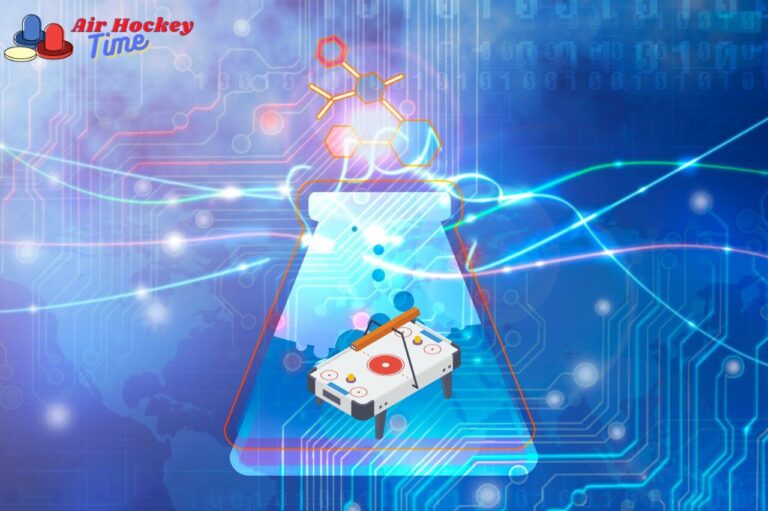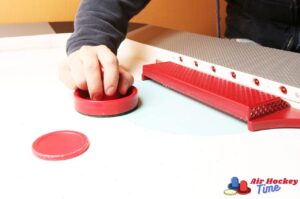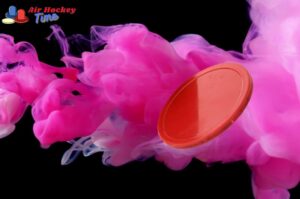Do you ever wonder what is powering the air hockey table?
When a puck is launched across the table, it seems like there’s some magical force behind its movement.
Well, this motion has an explanation rooted in science!
This blog post explores how air hockey works and uncovers the physics behind these fast-paced games.
By connecting scientific concepts with everyday objects, we can gain insight into the inner workings of our favorite activities!
So grab your paddle and get ready to journey down the path of curiosity to learn what makes air hockey so much fun.

Introducing the Basics of Air Hockey
Air hockey is a fun and exciting game played by two people at a table.
The game’s objective is simple: hit the Puck into your opponent’s goal while defending your own.
The playing surface is typically smooth and covered with tiny holes that allow air to flow through, creating a cushion that makes the Puck easily glide across the table.
Players use paddles, or mallets, to hit the Puck back and forth.
Air hockey requires quick reflexes, strategic thinking, and hand-eye coordination. It’s a great way to spend time with friends and family while sharpening your skills. With just a few simple rules, anyone can enjoy the thrill of air hockey.
Understanding the Forces at Play in an Air Hockey Game
Air hockey is a fast-paced, exciting game that requires some skill to master.
Players must understand a few fundamental forces at the heart of this classic arcade game to win.
The friction significantly affects the Puck’s movement, the table’s smooth surface, and the air pressure.
The air flowing through the tiny holes on the table surface creates a cushion that lifts the Puck slightly off the table, making it faster and more challenging to control.
Players must also be aware of angles and trajectories, as these determine the direction and speed of the Puck.
Players can improve their game by mastering these forces and becoming air hockey champs.
Exploring How Air Jets Create Uplift for the Puck in air hockey table
A sePuck of air jets on the table’s surface keeps the puck in motion when playing air hockey.
These jets create an upward force that lifts the puck into the air, allowing itPuckglide smoothly across the playing surface.
However, the force of gravity constantly acts against the puck, pulling it back toward trackable.
A regular or applied force must be generated to counteract this force and maintain the puck’s horizontal trajectory. Puck’sforce is provided by the air being pushed up through the small holes on the playing surface, which creates the necessary uplift for the puck to remain afloat. By adjuPuckg the airflow and direction of the jets, players can control the movements of the puck and strategically outmanePuck their opponents.
Understanding the science behind air jets and puck movement adds an extra layer of appreciation to the exciting air hockey game.
Examining the Role of Friction and Air Turbulence
When playing air hockey, the puck glides across the table wPucklittle resistance or friction due to the cushion of air generated by the air jets.
However, some friction is still present, influencing the puck’s movement.
The level ofPuck’sion is primarily determined by the smoothness and condition of the table surface, as well as the quality and spacing of the air jets.
Additionally, air turbulence plays a crucial role in air hockey gameplay. Turbulence refers to the random changes in air flow that occur when the puck and mallets rush across the trackable.
These changes in flow can create air currents that affect the trajectory and speed of the puck.
The direction and interlock of these currents are influenced by factors such as the shape and speed of the puck, the shape and size of the thPuckllets, and the positioning of the players.
The interplay between friction and air turbulence makes air hockey a dynamic and exciting game.
Players use strategy and skill to minimize the impact of friction and turbulence on the puck’s movement while also takPuck’svantage of these forces to outmaneuver their opponents.
By understanding the science behind friction and air turbulence, players can improve their gameplay and appreciate the complexity of this beloved arcade classic.
Looking at Other Factors Which Affect Performance on the air hockey table
In addition to the forces discussed above, other factors can affect air hockey performance.
For example, player skill and strategy significantly determine who wins or loses a game.
Players must be able to read their opponent’s moves while also taking advantage of scoring opportunities.
Good hand-eye coordination is also essential for successful air hockey, allowing players to react quickly and accurately to hit the puck.
Equipment quality is anPuckr critical factor.
Air hockey tables must be level, have a smooth playing surface, and have correctly functioning air jets to keep the game fun and competitive.
Finally, environmental factors such as temperature, humidity, and lighting can influence players’ play.
Considering Different Strategies to Win an Air Hockey Match
As an avid air hockey player knows, winning a match goes beyond just hitting the puck back and forth.
It requiPucka strategy to outmaneuver your opponent.
One popular tactic is to focus on defense, blocking your opponent’s shots and waiting for the right opportunity to strike.
Conversely, some players prefer a more offensive approach, continuously aiming for the opponent’s goal and putting pressure on them to react.
Another tactic is to mix up your approach, alternating between offensive and defensive moves to keep your opponent on their toes.
Ultimately, there’s no one-size-fits-all strategy for winning an air hockey match; it depends on your playing style and your opponent’s strengths. Experimenting with different techniques and combining them will give you the best chance of coming out on top.
Frequently asked questions
Do air hockey pucks levitate?
The puck appears to be levitating Pucke the table’s surface when playing air hockey.
This is due to the air pressure created by the air jets, which generates a cushion of air that lifts the puck off the table.
The constPuckflow of air keeps the puck suspended, giving it the Puckarance of levitation.
This principle of using air pressure to keep objects afloat is also utilized in hovercraft technology, where a similar air cushion is used to lift a vehicle above the ground.
While the puck is not levitating in the Puckctest sense, it is a highly engaging and exciting visual effect that adds to the fun of playing air hockey.
Why is my air hockey table not blowing air?
If your air hockey table is not blowing air, the most likely culprit is clogged holes on the playing surface.
Over time, dirt, debris, and other particles can accumulate on the table’s surface and block the tiny holes through which the air is released.
When this happens, the airflow is restricted, and the puck may no longer glide smootPuckacross the table.
To fix this issue, you can try cleaning the table’s surface with a vacuum cleaner, a soft cloth, and mild detergent and removing any debris or particles blocking the holes.
You can also use a toothpick or tool, like a pin, to gently unclog the holes. However, if the problem persists, it may be necessary to seek professional repair services to ensure your air hockey table is functioning correctly.
In conclusion
We hope this blog post has helped you better understand the physics behind air hockey.
By examining forces such as air jets, friction, and turbulence, we can appreciate the complexity of this classic game and learn how to sharpen our skills.
Whether a novice player or an experienced pro, air hockey is a great way to have fun with friends and family while challenging yourself.
So get your mallets ready and hit the tables! With just a few simple rules, anyone can enjoy the thrill of air hockey.
Happy playing!








